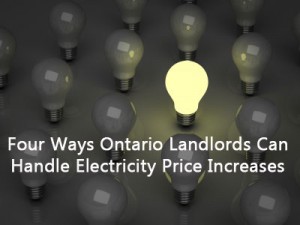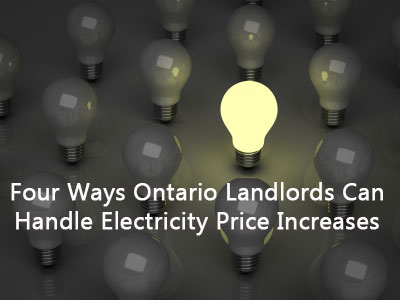 On November 1, 2015 the average household Hydro bill in Ontario increased by 3.4%. In 2010 the average monthly bill was $100, now the typical household will pay $131 per month. That is an increase of over 30% in the last five years. In addition to this, on January 1, 2016 the clean energy discount of 10% will also disappear, which will create an overall increase to the monthly bills.
On November 1, 2015 the average household Hydro bill in Ontario increased by 3.4%. In 2010 the average monthly bill was $100, now the typical household will pay $131 per month. That is an increase of over 30% in the last five years. In addition to this, on January 1, 2016 the clean energy discount of 10% will also disappear, which will create an overall increase to the monthly bills.
If you are a landlord who includes utilities like electricity in your rent you will notice that you are going to be losing cash flow and perhaps no longer able to keep your property profitable. This could potentially lead more landlords to sell their properties and provide less housing. So what can you do?
Well you should never give up and remember to be a proactive landlord, rather than a reactive landlord. A proactive landlord plans for these types of events and is able to handle them by using different strategies. Now not all of these strategies can be used in the middle of the tenancy, but keep in mind that utility costs are not decreasing any time soon and this will affect you, if you are charging inclusive rent. It is an important consideration when you’re pricing utilities into the rent for your properties.
1 . Rent your property not including the utilities. This can be a bit of a challenge in some areas where it is typical to rent the property including utilities, but while it’s easier to find a tenant, in the long term you could be making a lot less cash flow. When tenant’s turnover switch how utilities are paid.
2. Become more energy efficient. Use tools timers and energy efficient lightbulbs to reduce the cost of utilities. If your property has an electric forced air furnace you might consider using tools like the landlordstat (landlordstat.com). This tamperproof thermostat allows tenants to change the temperature of a unit only temporarily and then brings the temperature back down to a preset level. This alone could save hundreds of dollars per year.
There are also different saveONenergy coupons available for a variety of different energy efficient products. You can get coupons for LED light builbs, Energy Star certified light fixtures and ceiling fans, weatherstripping, hot water pipe wrap, electric water heater blanket, heavy duty outdoor timers and more.
3. In Ontario the maximum rent increase guideline is set by the province. In 2016 the rental increase guideline for Ontario is 2%. This is maximum a landlord can raise a tenant’s rent without the approval of the Landlord and Tenant Board. As a landlord in Ontario you can apply to the board to raise the rent above the annual guideline to a maximum of 3%. This process can take quite a long time but it allows you to increase your monthly rent up to an additional 3% per year over the guideline amount. This can be done if your utilities are considered extraordinary.
The definition of extraordinary is if the increased costs of the utility per month is greater than the rent increase guideline and an additional 50%.
So for example in 2015 the rent increase guideline is 2%. Since it is 2% extra ordinary would be considered 2% x .5 =1%
And 2% +1% equals 3%.
If the increase in utilities is greater than 3% per month it would be considered extraordinary, and you could apply for an above the guideline increase.
4. In Ontario, if your property were not occupied for any purpose before June 17, 1998, meaning that it was a new building, then the maximum amount which rents can be increased do not apply to the rental unit. Therefore you could raise the rent in line with your utility bills. Just remember you must be giving tenants an N2, and 90 days written notice when increasing the rent.
There are special programs in Ontario for low-income tenants as well. Tenants would need to meet certain criteria in order to participate in these programs, but the Ontario Electricity Support Program (OESP) and the Low-income Energy Assistance Program (LEAP) are some current examples.
We know that hydro rates are not coming down any time soon. So remember to be a proactive landlord, rather than a reactive landlord, and plan for future utility price increases.
Image courtesy of Master isolated images at FreeDigitalPhotos.net
